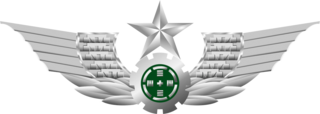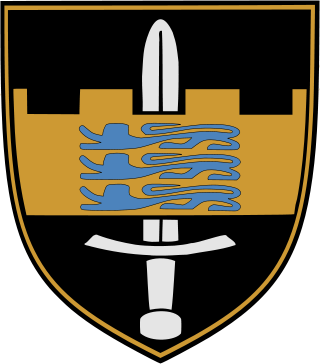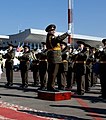
The Armed Forces of the Republic of Moldova consist of the National Army and the Trupele de Carabinieri under the Ministry of Internal Affairs. Until 2012, the Moldovan Border Police belonged to the armed forces.

Mechanized infantry are infantry units equipped with armored personnel carriers (APCs) or infantry fighting vehicles (IFVs) for transport and combat.

The 2S1 Gvozdika is a Soviet self-propelled howitzer introduced in 1972 and in service in Russia and other countries as of 2023. It is based on the MT-LBu multi-purpose chassis, mounting a 122 mm 2A18 howitzer. "2S1" is its GRAU designation. An alternative Russian designation is SAU-122, but in the Russian Army it is commonly known as Gvozdika. The 2S1 is fully amphibious with very little preparation, and once afloat is propelled by its tracks. A variety of track widths are available to allow the 2S1 to operate in snow or swamp conditions. It is NBC protected and has infrared night-vision capability.

The People's Liberation Army Ground Force is the land-based service branch of the People's Liberation Army and the largest and oldest branch of the entire Chinese armed forces. The PLAGF can trace its lineage from 1927 as the Chinese Red Army; however, it was not officially established until 1948.

The Romanian Land Forces is the army of Romania, and the main component of the Romanian Armed Forces. Since 2007, full professionalization and a major equipment overhaul have transformed the nature of the Land Forces.

The Transnistria War was an armed conflict that broke out on 2 November 1990 in Dubăsari between pro-Transnistria forces, including the Transnistrian Republican Guard, militia and neo-Cossack units, which were supported by elements of the Russian 14th Army, and pro-Moldovan forces, including Moldovan troops and police.

The second Jassy–Kishinev offensive, named after the two major cities, Jassy and Kishinev, in the staging area, was a Soviet offensive against Axis forces, which took place in Eastern Romania from 20 to 29 August 1944 during World War II. The 2nd and 3rd Ukrainian Fronts of the Red Army engaged Army Group South Ukraine, which consisted of combined German and Romanian formations, in an operation to reoccupy Bessarabia and destroy the Axis forces in the region, opening the way into Romania and the Balkans.

The Royal Jordanian Army is the ground force branch of the Jordanian Armed Forces (JAF). It draws its origins from units such as the Arab Legion, formed in the British Mandate of Transjordan in the 1920s. It has seen combat against Israel in 1948, 1956, 1967, and 1973. The Army also fought the Syrians and the PLO during Black September in 1970.

The Hungarian Ground Forces constitute the land branch of the Hungarian Defence Forces, responsible for ground activities and troops, including artillery, tanks, Armoured Personnel Carriers (APCs), Infantry Fighting Vehicles (IFVs), and ground support. The ground forces have a history of service in Iraq and are currently engaged in the KFOR operation.

The Saudi Arabian Army, officially the Royal Saudi Land Forces, is the principle land warfare branch of the Armed Forces of Saudi Arabia. It is part of the Saudi Ministry of Defense, which is one of the two military departments of the government of Saudi Arabia, together with the Ministry of National Guard.

The Battle of Abu-Ageila was a military confrontation between the Israel Defense Forces and the Egyptian Army in the Six-Day War of June 1967. The decisive defeat of the Egyptians was critical to the eventual loss of the entire Sinai Peninsula to Israel. Leading Israeli forces was Major General Ariel Sharon, later a prominent politician and prime minister of Israel.

The Estonian Land Forces, unofficially referred to as the Estonian Army, is the name of the unified ground forces among the Estonian Defense Forces where it has an offensive military formation role. It is currently the largest Estonian military branch, with an average size of approximately 6,000 soldiers, conscripts, and officers during peacetime.

Mechanized Infantry Forces of Ukraine are the general basis and primary combat formations of the Ukrainian Ground Forces. They execute tasks of holding the occupied areas, lines and positions tasks of enemy's impacts repelling, of penetrating the enemy's defense lines, defeating the enemy forces, capturing the important areas, lines and objectives, and can operate in structure of marine and landing troops.

The Yugoslav Ground Forces was the ground forces branch of the Yugoslav People's Army (JNA) from 1 March 1945 until 20 May 1992 when the last remaining remnants were merged into the Ground Forces of the new Federal Republic of Yugoslavia, under the threat of sanctions.

The Armed Forces of the Pridnestrovian Moldavian Republic are the military forces of the unrecognized state of Transnistria. The Armed Forces fall under the leadership of the Ministry of Defence. The Armed Forces were created on 6 September 1991 to maintain the sovereignty and independence of the Pridnestrovian Moldavian Republic, in accordance with Article 11 of the Republic's Constitution.
The Angolan Army is the land component of the Angolan Armed Forces (FAA).

On October 8, 1950, 3rd Tank Division(Chinese: 战车第3师) was formed in Siping, Jilin province from 1st Independent Division, Northwestern Military Region.
The 55th Light Combined Arms Brigade, formerly the 55th Division, is a military formation of the People's Liberation Army Ground Force of the People's Republic of China. It is now one of six combined arms brigades of the PLA 77th Group Army.
The 64th Group Army, former 64th Corps and 64th Army Corps, was a military formation of China's People's Liberation Army that existed from 1949 to 1998.

The Chișinău Independence Day Parade is one of the events of the Independence Day of Moldova held by the Moldovan National Army. The parade is held in Chișinău, Moldova on August 27 every 5 to 10 years on Great National Assembly Square.
























